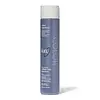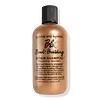What's inside
What's inside
 Key Ingredients
Key Ingredients

 Benefits
Benefits

 Concerns
Concerns

 Ingredients Side-by-side
Ingredients Side-by-side

Water
Skin ConditioningDisodium Laureth Sulfosuccinate
CleansingCocamidopropyl Betaine
CleansingPEG-150 Distearate
EmulsifyingSodium Cocoyl Isethionate
CleansingSodium Lauroyl Sarcosinate
CleansingParfum
MaskingPEG-120 Methyl Glucose Dioleate
EmulsifyingPanthenol
Skin ConditioningPolyquaternium-10
Hydrolyzed Quinoa
Skin ConditioningDisodium EDTA
Glycol Distearate
EmollientCitric Acid
BufferingDimethicone PEG-8 Meadowfoamate
EmollientSteareth-4
EmulsifyingButylphenyl Methylpropional
PerfumingPolyquaternium-7
Butylene Glycol
HumectantLinalool
PerfumingHydroxycitronellal
PerfumingGeraniol
PerfumingMagnesium Nitrate
Citronellol
PerfumingPhytantriol
HumectantSodium Benzoate
MaskingPhenoxyethanol
PreservativePotassium Sorbate
PreservativeIsopropyl Alcohol
SolventPPG-33-Buteth-45
Skin ConditioningSodium Chloride
MaskingEthylhexylglycerin
Skin ConditioningMethylchloroisothiazolinone
PreservativeMagnesium Chloride
Methylisothiazolinone
PreservativeCI 17200
Cosmetic ColorantHydrolyzed Rhodophyceae Extract
Hypnea Musciformis Extract
Skin ProtectingWater, Disodium Laureth Sulfosuccinate, Cocamidopropyl Betaine, PEG-150 Distearate, Sodium Cocoyl Isethionate, Sodium Lauroyl Sarcosinate, Parfum, PEG-120 Methyl Glucose Dioleate, Panthenol, Polyquaternium-10, Hydrolyzed Quinoa, Disodium EDTA, Glycol Distearate, Citric Acid, Dimethicone PEG-8 Meadowfoamate, Steareth-4, Butylphenyl Methylpropional, Polyquaternium-7, Butylene Glycol, Linalool, Hydroxycitronellal, Geraniol, Magnesium Nitrate, Citronellol, Phytantriol, Sodium Benzoate, Phenoxyethanol, Potassium Sorbate, Isopropyl Alcohol, PPG-33-Buteth-45, Sodium Chloride, Ethylhexylglycerin, Methylchloroisothiazolinone, Magnesium Chloride, Methylisothiazolinone, CI 17200, Hydrolyzed Rhodophyceae Extract, Hypnea Musciformis Extract
Water
Skin ConditioningSodium Cocoyl Isethionate
CleansingSodium Lauroyl Sarcosinate
CleansingSodium Lauryl Sulfoacetate
CleansingPropanediol
SolventCoco-Betaine
CleansingAcrylates Copolymer
Honey
HumectantHydrogenated Castor Oil/Sebacic Acid Copolymer
EmollientYeast Extract
Skin ConditioningOctyldodecyl Citrate Crosspolymer
HumectantHydroxypropylgluconamide
HumectantHydroxypropylammonium Gluconate
HumectantGuar Hydroxypropyltrimonium Chloride
Skin ConditioningPhenyl Trimethicone
Skin ConditioningCaprylyl Glycol
EmollientPanthenol
Skin ConditioningPolysorbate 20
EmulsifyingGlycol Distearate
EmollientButyl Methoxydibenzoylmethane
UV AbsorberEthylhexyl Methoxycinnamate
UV AbsorberSodium Methyl Cocoyl Taurate
CleansingPEG-150 Distearate
EmulsifyingPolyquaternium-7
Silica
AbrasiveButylene Glycol
HumectantCitric Acid
BufferingTartaric Acid
BufferingSodium Hydroxide
BufferingSodium Chloride
MaskingBHT
AntioxidantParfum
MaskingLimonene
PerfumingBenzyl Salicylate
PerfumingLinalool
PerfumingTetrasodium EDTA
Sodium Benzoate
MaskingPotassium Sorbate
PreservativePhenoxyethanol
PreservativeMica
Cosmetic ColorantCI 77891
Cosmetic ColorantWater, Sodium Cocoyl Isethionate, Sodium Lauroyl Sarcosinate, Sodium Lauryl Sulfoacetate, Propanediol, Coco-Betaine, Acrylates Copolymer, Honey, Hydrogenated Castor Oil/Sebacic Acid Copolymer, Yeast Extract, Octyldodecyl Citrate Crosspolymer, Hydroxypropylgluconamide, Hydroxypropylammonium Gluconate, Guar Hydroxypropyltrimonium Chloride, Phenyl Trimethicone, Caprylyl Glycol, Panthenol, Polysorbate 20, Glycol Distearate, Butyl Methoxydibenzoylmethane, Ethylhexyl Methoxycinnamate, Sodium Methyl Cocoyl Taurate, PEG-150 Distearate, Polyquaternium-7, Silica, Butylene Glycol, Citric Acid, Tartaric Acid, Sodium Hydroxide, Sodium Chloride, BHT, Parfum, Limonene, Benzyl Salicylate, Linalool, Tetrasodium EDTA, Sodium Benzoate, Potassium Sorbate, Phenoxyethanol, Mica, CI 77891
Ingredients Explained
These ingredients are found in both products.
Ingredients higher up in an ingredient list are typically present in a larger amount.
Butylene Glycol (or BG) is used within cosmetic products for a few different reasons:
Overall, Butylene Glycol is a safe and well-rounded ingredient that works well with other ingredients.
Though this ingredient works well with most skin types, some people with sensitive skin may experience a reaction such as allergic rashes, closed comedones, or itchiness.
Learn more about Butylene GlycolCitric Acid is an alpha hydroxy acid (AHA) naturally found in citrus fruits like oranges, lemons, and limes.
Like other AHAs, citric acid can exfoliate skin by breaking down the bonds that hold dead skin cells together. This helps reveal smoother and brighter skin underneath.
However, this exfoliating effect only happens at high concentrations (20%) which can be hard to find in cosmetic products.
Due to this, citric acid is usually included in small amounts as a pH adjuster. This helps keep products slightly more acidic and compatible with skin's natural pH.
In skincare formulas, citric acid can:
While it can provide some skin benefits, research shows lactic acid and glycolic acid are generally more effective and less irritating exfoliants.
Most citric acid used in skincare today is made by fermenting sugars (usually from molasses). This synthetic version is identical to the natural citrus form but easier to stabilize and use in formulations.
Read more about some other popular AHA's here:
Learn more about Citric AcidGlycol Distearate serves as a pearlizing or opacifying agent in cosmetic products.
It's often included in cleansers and haircare products to give them a lustrous or shimmering appearance.
It is derived from stearic acid, a natural fatty acid commonly found in vegetable oils and animal fats.
Glycol Distearate isn't fungal acne safe.
Learn more about Glycol DistearateLinalool is a fragrance and helps add scent to products. It's derived from common plants such as cinnamon, mint, citrus, and lavender.
Like Limonene, this ingredient oxidizes when exposed to air. Oxidized linalool can cause allergies and skin sensitivity.
This ingredient has a scent that is floral, spicy tropical, and citrus-like.
Learn more about LinaloolPanthenol is a common ingredient that helps hydrate and soothe the skin. It is found naturally in our skin and hair.
There are two forms of panthenol: D and L.
D-panthenol is also known as dexpanthenol. Most cosmetics use dexpanthenol or a mixture of D and L-panthenol.
Panthenol is famous due to its ability to go deeper into the skin's layers. Using this ingredient has numerous pros (and no cons):
Like hyaluronic acid, panthenol is a humectant. Humectants are able to bind and hold large amounts of water to keep skin hydrated.
This ingredient works well for wound healing. It works by increasing tissue in the wound and helps close open wounds.
Once oxidized, panthenol converts to pantothenic acid. Panthothenic acid is found in all living cells.
This ingredient is also referred to as pro-vitamin B5.
Learn more about PanthenolParfum is a catch-all term for an ingredient or more that is used to give a scent to products.
Also called "fragrance", this ingredient can be a blend of hundreds of chemicals or plant oils. This means every product with "fragrance" or "parfum" in the ingredients list is a different mixture.
For instance, Habanolide is a proprietary trade name for a specific aroma chemical. When used as a fragrance ingredient in cosmetics, most aroma chemicals fall under the broad labeling category of “FRAGRANCE” or “PARFUM” according to EU and US regulations.
The term 'parfum' or 'fragrance' is not regulated in many countries. In many cases, it is up to the brand to define this term.
For instance, many brands choose to label themselves as "fragrance-free" because they are not using synthetic fragrances. However, their products may still contain ingredients such as essential oils that are considered a fragrance by INCI standards.
One example is Calendula flower extract. Calendula is an essential oil that still imparts a scent or 'fragrance'.
Depending on the blend, the ingredients in the mixture can cause allergies and sensitivities on the skin. Some ingredients that are known EU allergens include linalool and citronellol.
Parfum can also be used to mask or cover an unpleasant scent.
The bottom line is: not all fragrances/parfum/ingredients are created equally. If you are worried about fragrances, we recommend taking a closer look at an ingredient. And of course, we always recommend speaking with a professional.
Learn more about ParfumPeg-150 Distearate is an emulsifier and thickening agent. It is created from stearic acid.
As an emulsifier, peg-150 distearate helps other ingredients dissolve. This helps prevent ingredient separation.
This ingredient may not be Malassezia folliculitis, or fungal-acne safe.
Learn more about PEG-150 DistearatePhenoxyethanol is a preservative that has germicide, antimicrobial, and aromatic properties. Studies show that phenoxyethanol can prevent microbial growth. By itself, it has a scent that is similar to that of a rose.
It's often used in formulations along with Caprylyl Glycol to preserve the shelf life of products.
Polyquaternium-7 is a light to clear colored liquid. It is commonly found in haircare products for its film-forming and anti-static properties.
According to a manufacturer, it is a non-paraben and specially developed for negatively charged surfactant systems. This makes it a great hairstyle holder and helps to improve wet hair detangling without adding buildup.
Potassium Sorbate is a preservative used to prevent yeast and mold in products. It is commonly found in both cosmetic and food products.
This ingredient comes from potassium salt derived from sorbic acid. Sorbic acid is a natural antibiotic and effective against fungus.
Both potassium sorbate and sorbic acid can be found in baked goods, cheeses, dried meats, dried fruit, ice cream, pickles, wine, yogurt, and more.
You'll often find this ingredient used with other preservatives.
Learn more about Potassium SorbateSodium Benzoate is a preservative. It's used in both cosmetic and food products to inhibit the growth of mold and bacteria. It is typically produced synthetically.
Both the US FDA and EU Health Committee have approved the use of sodium benzoate. In the US, levels of 0.1% (of the total product) are allowed.
Sodium benzoate works as a preservative by inhibiting the growth of bacteria inside of cells. It prevents the cell from fermenting a type of sugar using an enzyme called phosphofructokinase.
It is the salt of benzoic acid. Foods containing sodium benzoate include soda, salad dressings, condiments, fruit juices, wines, and snack foods.
Studies for using ascorbic acid and sodium benzoate in cosmetics are lacking, especially in skincare routines with multiple steps.
We always recommend speaking with a professional, such as a dermatologist, if you have any concerns.
Learn more about Sodium BenzoateChances are, you eat sodium chloride every day. Sodium Chloride is also known as table salt.
This ingredient has many purposes in skincare: thickener, emulsifier, and exfoliator.
You'll most likely find this ingredient in cleansers where it is used to create a gel-like texture. As an emulsifier, it also prevents ingredients from separating.
There is much debate on whether this ingredient is comedogenic. The short answer - comedogenic ratings don't tell the whole story. Learn more about comegodenic ratings here.
The concensus about this ingredient causing acne seems to be divided. Research is needed to understand if this ingredient does cause acne.
Scrubs may use salt as the primary exfoliating ingredient.
Learn more about Sodium ChlorideSodium cocoyl isethionate is a natural ingredient from coconut oil. It is an ultra gentle cleanser that gives a nice foam without drying the skin or impacting the skin barrier.
The amount of foam created depends on the amount of sodium cocoyl isethionate used in the product.
This ingredient also helps improve the spreadability of a product.
Learn more about Sodium Cocoyl IsethionateSodium Lauroyl Sarcosinate is a cleansing agent and emulsifier. It is a surfactant derived from sarcosine, and a common source is coconut oil.
As a surfactant, Sodium Lauroyl Sarcosinate helps lift dirts, oil, and other molecules to be washed away. In leave-on products, this ingredient is used as an emulsifier. Emulsifier help prevent ingredients such as oils and waters from separating.
Sodium Lauroyl Sarcosinate is also commonly found as a foaming agent in shampoo, toothpaste, and shaving foam. It is amphiphilic, meaning it loves both water and fats.
Learn more about Sodium Lauroyl SarcosinateWater. It's the most common cosmetic ingredient of all. You'll usually see it at the top of ingredient lists, meaning that it makes up the largest part of the product.
So why is it so popular? Water most often acts as a solvent - this means that it helps dissolve other ingredients into the formulation.
You'll also recognize water as that liquid we all need to stay alive. If you see this, drink a glass of water. Stay hydrated!
Learn more about Water